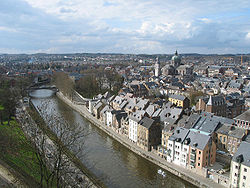Sambre
| Sambre | |
|---|---|
 The Sambre in the centre of Namur | |
 | |
| Physical characteristics | |
| Source | |
| • location | Picardy |
| • elevation | 199 m (653 ft) |
| Mouth | |
• location | Meuse at Namur |
| Length | 193 km (120 mi) |
| Basin size | 2,740 square kilometres (1,060 sq mi) |
| Basin features | |
| Progression | Meuse→ North Sea |
The Sambre is a river in northern France and in Wallonia, Belgium. It is a left tributary of the Meuse.
Course
The source of the Sambre is near Le Nouvion-en-Thiérache, in the Aisne department. It passes through the Franco-Belgian coal basin, formerly an important industrial district. Its Belgian portion was at the western end of the sillon industriel, which was Wallonia's industrial backbone. It is canalized along much of its length and flows into the Meuse at Namur, Belgium. The Sambre is connected with the Oise by the Sambre-Oise Canal.
The Sambre flows through the following departments of France, provinces of Belgium and towns:
- Aisne (F): Barzy-en-Thiérache
- Nord (F): Landrecies, Aulnoye-Aymeries, Hautmont, Maubeuge
- Hainaut (B): Thuin, Montigny-le-Tilleul, Charleroi
- Namur (B): Floreffe, Namur
-
The Sambre at Aulne Abbey in Belgium
-
The Sambre at Flawinne (Namur)
-
The Sambre at Ham-sur-Sambre
-
The Sambre at Moustier-sur-Sambre
Main tributaries
Events
- The mother of René Magritte, a famous surrealist painter, killed herself by drowning in this river.
Battles
The 19th-century theory that the Sambre was the location of Julius Caesar's battle against a Belgic confederation (57 BC), was discarded a long time ago,[3] but is still repeated.
Heavy fighting occurred along the river during World War I, especially at the siege of Namur in 1914 (Battle of Charleroi) and in the last month of the war (Battle of the Sambre (1918)).
References
- ^ a b c d e f g h i j k l m "Contrats de rivière en Wallonie - Sambre". Environnement.wallonie.be. Retrieved July 2014.
{{cite web}}: Check date values in:|accessdate=(help) - ^ "Le Ruisseau "le Piéton" - Piéton, Village du Hainaut". Pieton.eu. Retrieved July 2014.
{{cite web}}: Check date values in:|accessdate=(help) - ^ Pierre Turquin ("La Bataille de la Selle (du Sabis) en l' An 57 avant J.-C." in Les Études Classiques 23/2 (1955), 113-156) has proved beyond reasonable doubt that the battle was fought at the River Selle, west of modern Saulzoir.
External links
- The Sambre at the Sandre database




